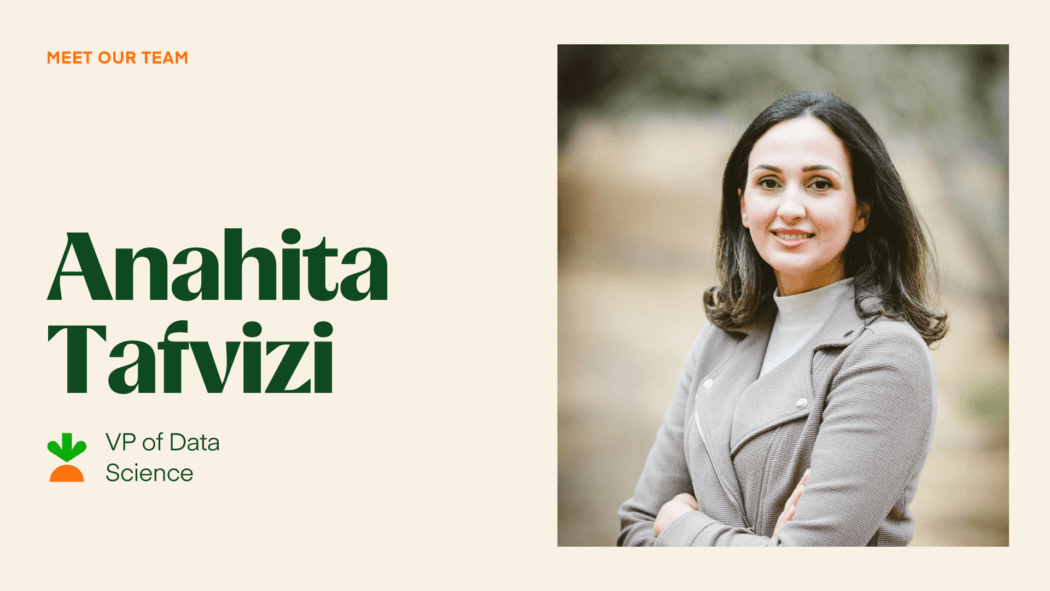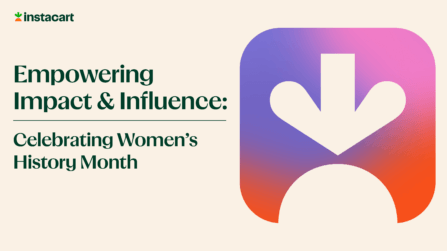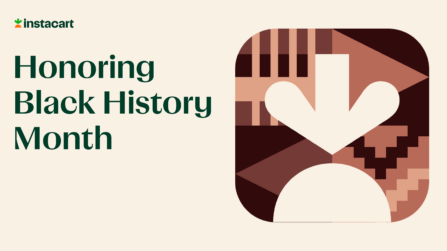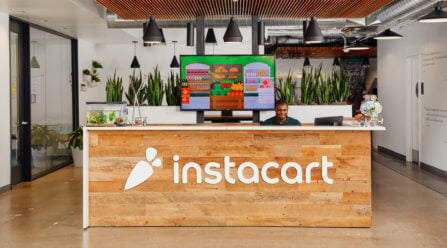Taste of Instacart
Building a Data-Driven company with Anahita Tafvizi, Instacart’s Vice President and Head of Data Science

Anahita Tafvizi joined Instacart in early 2021 and today, she leads the Data Science team which has more than doubled in size during her tenure. Our Data Science team is charged with identifying and informing decisions that improve the entire Instacart experience for our four-sided marketplace: customers, shoppers, retailers and advertisers. The team partners with product management, design, engineering, and research on every aspect of the product life cycle, from ideation to execution to measurement.
We sat down with Anahita to talk about her vision and approach to building the Data Science organization, what the team is working on and what’s next.
What is your role at Instacart and what is your team responsible for?
I lead our Data Science team, which is responsible for all data analytics, insights and experimentation at the company. We partner with our Product and Engineering teams on all stages of the product life cycle, from ideation and prioritization, to execution, iteration and optimizations on all our product lines. We also support executive decision making across all product pillars, ensuring that data is at the center of decisions on what Instacart prioritizes and resources at all levels.
What has your career path looked like? Why did you decide to join Instacart?
I spent my early career in a combination of academia and consulting, learning about both technical problem solving and the world of business and organizational leadership. In 2012, through a combination of luck and looking for Bay Area-based roles when my first daughter was born, I moved to the tech industry. For the last decade, I have held a variety of leadership roles in Finance, Strategy, Analytics and Data Science in the tech space. In my last role at Google, I led the Finance team for Google Commerce & Shopping, where I learned about the challenges of achieving positive unit economics in Grocery e-commerce. When I started to talk with Instacart leadership, I already had a deep appreciation for what they had built, and the more I learned about the complexity of optimizing in a four-sided marketplace, the more excited I got. Moreover, I’m passionate about Instacart’s mission to provide access to food for everyone, one of the most basic needs in any society. When the opportunity arose to join the data science team at the forefront of solving these challenges, at a company I really believe in, I had to jump on it!
How is data science structured at Instacart? How does the team partner with the rest of the company?
The Data Science team is a central function within Instacart. We are organized based on the sides of the marketplace: consumers, retailers, shoppers, and advertisers. We share the same structure as our key partners in Product, Engineering, and Design. Every product we build comes as a partnership between a data scientist, product manager, engineer, and designer, working cross functionally as a core team.
This structure gives us the best of both worlds: as a central function, we are able to cultivate a real community and identity as data scientists, focused on providing objective learnings to improve the quality of decisions. But we also embed deeply across other teams and gain the substantive expertise to influence the direction of the product, from planning to execution.
Instacart data science is in a really exciting middle ground between having the maturity of tools and engineering to build great products while still being in a phase of growth where there are a lot of insights to be discovered or understood.
What differentiates Data Science at Instacart from other companies you’ve worked at?
There are a few things I would call out. First is the fact that there is no shortage of interesting problems to solve in a four-sided marketplace. We have team members that have joined us from other marketplace companies and they are consistently struck by the complexity of the problems we solve at Instacart, and the number of times we have to think about trade-offs in decisions. Second is the data-driven culture of the company that is evident in every aspect of the product life cycle and all key decisions. We use experiments and observational causal inference to support decisions about everything from which features to ship to how to prioritize resources across teams. This keeps us on our toes and requires us to constantly develop new methodologies, tools and infrastructure to enable the team to keep up with the complexity and speed of the business. More generally, Instacart data science is in a really exciting middle ground between having the maturity of tools and engineering to build great products while still being in a phase of growth where there are a lot of insights to be discovered or understood. This means there are a lot of opportunities for impactful strategic findings around which we can quickly and effectively build products, rather than just optimizing more mature products.
Can you share an example of a result that your team has achieved that you are most proud of?
It’s tough to pick just one! The Data Science team has done great work that has driven incredible business results across our consumers, shoppers, retailers and advertisers.
I previously led the Ads DS team here at Instacart, so this example is close to my heart: our team developed the first-ever advertiser-facing lift test studies, which helped measure the true effectiveness of ads campaigns in partnership with many of our advertisers. The Data Science team was at the forefront of the effort, which required deep collaboration between Product, Engineering, Ads Sales, and of course our advertising partners. Showing the effectiveness of our ads campaign through objective measurement enhanced the trust of advertisers in our ads products and resulted in unlocking incremental budgets from our advertisers and in delivering substantial results to our partners.
There are many other examples of innovation across the org, from increasing the efficiency of shopper in-store navigation and delivery routing, to customer segmentations that improve the personalization systems in the Instacart app, so that it’s easier to find baby formula or your cat’s favorite food on Instacart. Our team has also leveraged analyses and experimentation to change the way retailers use Instacart data to prioritize the goods and services they provide to their customers. It’s exciting to have conversations with retailers using data as a driver, and not just relying on intuition or long-standing opinions.
You’ve led tremendous growth for the Data Science org, what do you look for when interviewing candidates?
Three related qualities I look for in data scientists are (1) objectivity; (2) ability to identify and name risks; and (3) accountability to and ownership of business results. I try to ask questions that gauge these qualities: When have you had to deliver bad news? Hold your ground and be objective in the face of a misalignment among a cross-functional group? I look for candidates who were able to turn a challenging situation into one that strengthened trust with their core cross-functional partners.
Two of the questions I asked in all of these meetings were, “what would you do if you were in my shoes?” and “how can I help make your job easier?” The answer to these questions helped me set priorities for myself and my leadership team focused on growing and developing our talent, creating community (especially in the world of flex-first), and improving our tooling and infrastructure.
What are some of your priorities for the Data Science organization?
I did a listening tour across the org when I took the role to lead the Data Science team back in 2021. Two of the questions I asked in all of these meetings were, “what would you do if you were in my shoes?” and “how can I help make your job easier?” The answer to these questions helped me set priorities for myself and my leadership team focused on growing and developing our talent, creating community (especially in the world of flex-first), and improving our tooling and infrastructure.
In addition to these organizational goals, I want the Data Science team to really have an equal voice in the strategy and direction of the company. Since we embed closely with the Product teams, we’re jointly accountable for the goals we set. But in addition, our team defines our own “understand” roadmaps and goals to ensure we’re helping the company see around corners and identify the next big opportunity to grow and improve the Instacart experience.
Interested in learning more about Data Science at Instacart? Read about the problems we’re solving on the our Engineering blog and check out opportunities on the team.
Most Recent in Taste of Instacart

Taste of Instacart
Empowering Impact & Influence: Celebrating Women’s History Month
Every March, we take time to honor and celebrate Women’s History Month at Instacart. This year’s celebrations, led by our Women@ Instacart Employee Resource Group (ERG), focused on the theme of Empowering Impact and Influence,…...
Mar 29, 2024
Taste of Instacart
Meet Andy Chiu, VP of Ads Engineering at Instacart
While he may only be a few months into his new role as VP of Ads Engineering at Instacart, Andy Chiu has hit the ground running, already empowering his team to reach a growing list…...
Mar 12, 2024
Taste of Instacart
Honoring Black History Month at Instacart
In February, we partnered with Instacart’s Nightshades — our Black Employee Resource Group (ERG) — to celebrate and recognize Black History Month. This year’s theme, Forging New Frontiers, helped shine a spotlight on Black visionary…...
Mar 1, 2024

 Building an Inclusive PM team for Instacart Ads with Ali Miller, Instacart’s Senior Director of Product Management
Building an Inclusive PM team for Instacart Ads with Ali Miller, Instacart’s Senior Director of Product Management  Data Engineering and Infrastructure at Instacart with Engineering Manager Abhi Kalakuntla
Data Engineering and Infrastructure at Instacart with Engineering Manager Abhi Kalakuntla  Introducing Flex First, Instacart’s Future of Work
Introducing Flex First, Instacart’s Future of Work  Joining Our Table: Meet Chief Operating Officer Asha Sharma
Joining Our Table: Meet Chief Operating Officer Asha Sharma 
